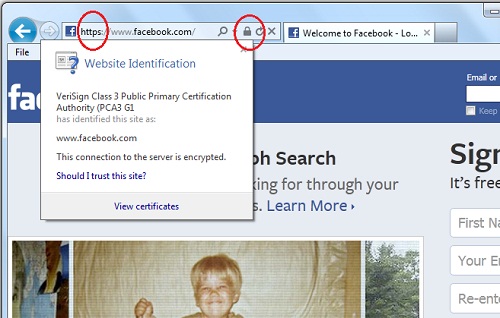Cryptography Tutorials - Herong's Tutorial Examples - v5.42, by Herong Yang
Visiting a "https" Web Site with IE
This section describes how IE (Internet Explorer) 9 shows a lock icon when you visit an 'https' Web site to provide you more security related information.
As I mentioned in the previous section, if a Web site wants to encrypt communication messages with your browser, it will enable the SSL protocol and use "https" as part of their Web address.
If you go to a Web site that provides online services, I am sure that you will see "https" in the Web address field starting on the log in page. This indicates that Web site uses SSL protocol to encrypt all information you send and receive on this server.
If you are using IE (Internet Explorer) 11, it will display an extra lock icon next to the Web address field when you are connecting to an "https" Web site. The picture below shows the "https" Web address and the lock icon when you use IE to visit the Facebook log in page at https://www.facebook.com.

If you click the lock icon, IE will provide you a summary of security related information about this Web site. For https://www.facebook.com Web site, you will get something like:
VeriSign Class 3 Public Primary Certification Authority (PCA3 G1 has identified this site as: www.facebook.com This connection to the server is encrypted.
More security related information will be provided if you click the "View certificates" button. See next sections.
Table of Contents
Introduction to AES (Advanced Encryption Standard)
DES Algorithm - Illustrated with Java Programs
DES Algorithm Java Implementation
DES Algorithm - Java Implementation in JDK JCE
DES Encryption Operation Modes
PHP Implementation of DES - mcrypt
Blowfish - 8-Byte Block Cipher
Secret Key Generation and Management
Cipher - Secret Key Encryption and Decryption
RSA Implementation using java.math.BigInteger Class
Introduction of DSA (Digital Signature Algorithm)
Java Default Implementation of DSA
Private key and Public Key Pair Generation
PKCS#8/X.509 Private/Public Encoding Standards
Cipher - Public Key Encryption and Decryption
OpenSSL Introduction and Installation
OpenSSL Generating and Managing RSA Keys
OpenSSL Generating and Signing CSR
OpenSSL Validating Certificate Path
"keytool" and "keystore" from JDK
"OpenSSL" Signing CSR Generated by "keytool"
Migrating Keys from "keystore" to "OpenSSL" Key Files
Certificate X.509 Standard and DER/PEM Formats
Migrating Keys from "OpenSSL" Key Files to "keystore"
►Visiting a "https" Web Site with IE
Installing Certificate Permanently in IE
Managing Certificates in Certificate Stores with IE
Exporting Certificates Out of IE
OpenSSL Viewing Certificates Exported from IE
Importing CA Certificate into IE
Importing Certificate Path into IE